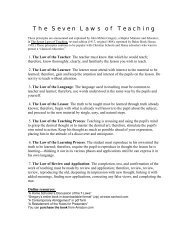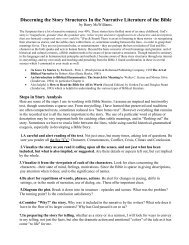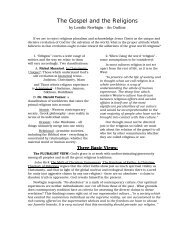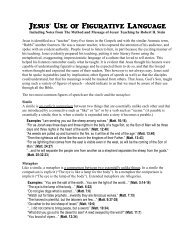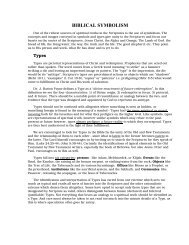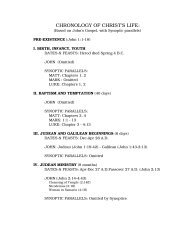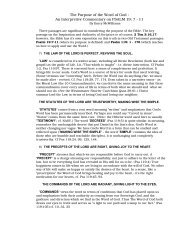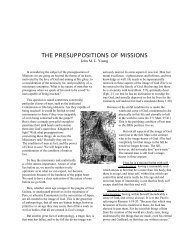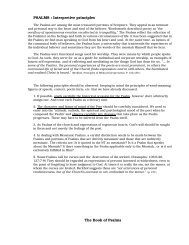Carcassonne
Carcassonne
Carcassonne
You also want an ePaper? Increase the reach of your titles
YUMPU automatically turns print PDFs into web optimized ePapers that Google loves.
<strong>Carcassonne</strong><br />
Based on Rules by Klaus-Jurgen Wrede and Rio Grande Games (with some added alternate and house rules from<br />
Board Game Geek forums, etc.)<br />
This pamphlet outlines all of the rules for <strong>Carcassonne</strong> and its expansions along with some variations and alternate<br />
rules. Where applicable, rules specific to an expansion are identified as such. The following expansions and<br />
variations are covered herein:<br />
<strong>Carcassonne</strong><br />
<strong>Carcassonne</strong> (The River)<br />
<strong>Carcassonne</strong> (Inns & Cathedrals)<br />
<strong>Carcassonne</strong> (Traders & Builders)<br />
<strong>Carcassonne</strong> (King & Scout)<br />
<strong>Carcassonne</strong> (The Count of <strong>Carcassonne</strong>)<br />
<strong>Carcassonne</strong> (The Princess and the Dragon)<br />
Plus additional rules added for:<br />
(River II House rules)<br />
(Lakes and Fishermen)<br />
(Landlord and Friar)<br />
The Cathars (Siege tiles)<br />
With respect to all alternate rules, all players must agree before game play begins whether the alternate rule should<br />
be an aspect of the game play.<br />
Players <strong>Carcassonne</strong> is a game for 2-6 players.<br />
Pieces<br />
Inns & Cathedrals: 2-6 players<br />
Each player starts the game with seven (7) followers, placing the eighth piece on the scoring track.<br />
Inns & Cathedrals: +1 large follower<br />
Traders & Builders: +1 pig, +1 builder<br />
Turn Summary<br />
A turn consists of the following:<br />
• The player must draw a tile from the stack (or the draw bag) and place it on the board. Or players may<br />
choose to have “hands” of 3 tiles. They draw a replacement tile to replenish the hand at the end of their<br />
turn.<br />
• The player may deploy one of his followers from his available supply on the tile just played.<br />
• If, by placing the tile, it completes cities, roads, or cloisters, they are scored.<br />
The Count of <strong>Carcassonne</strong>: If a tile was placed such that at least one of a player’s opponents scored<br />
while the placing player scored nothing, the placing player may, at the end of his turn, place one (1)<br />
follower from his supply into any <strong>Carcassonne</strong> city quarter. This placement is in addition to any follower<br />
placed as part of the player’s normal turn. When a follower is placed in <strong>Carcassonne</strong>, the player may also<br />
choose to move the Count to another quarter of the city (the Count never leaves the city). Followers<br />
placed within <strong>Carcassonne</strong> cannot leave the city except during the scoring of a road, city, cloister, or farm.<br />
NOTE: when scoring later on, the Count prevents followers in the same quarter from being moved at all.<br />
Placing a Tile<br />
In order to place a tile, it must be placed according to the following rules:<br />
• with at least one edge abutting one previously place tile (they cannot be placed corner to corner).<br />
• so that all field, city, and road segments on the new tile continue to the same terrain on the abutting tile.<br />
• Special rule for lake pieces – after the first lake tile is placed, additional lake tiles must be added to an<br />
existing lake or its shorelines, and played elsewhere only if there is nowhere that that piece can be played<br />
on an existing lake.<br />
Traders & Builders: When a city is completed that has 1 or more trade good symbols, the player who<br />
placed the tile to complete the city takes a trade good token for each trade good symbol in the city. NOTE:<br />
It does not matter whether the player has any followers within the city. These tokens will contribute to<br />
end-game scoring. Lakes The same applies to the fish tokens when lakes are completed.
In the rare event that the drawn tile cannot be placed legally on the board (and all players agree), the tile is<br />
discarded and the player draws another tile.<br />
Alternate Rule (home rule): the tile is simply returned to the stack (or the draw bag).<br />
Alternate Rule (Hans Andersson): When a tile is placed within a ‘hole’ (an empty space where a tile can<br />
be placed wherein three or four (3+) sides are already occupied), the player receives a bonus turn (similar<br />
to the Traders & Builders builder rule). Only one bonus turn can be received at a time. The bonus turn<br />
takes place immediately following the scoring as is exactly like another turn.<br />
Deploying Followers (Meeples)<br />
In order to play a follower, the following rules apply:<br />
• only one (1) follower may be deployed per turn<br />
• the follower must be taken from the player’s available supply<br />
• the follower can only be deployed to the tile just placed<br />
• followers may NOT be deployed on a field, city, or road segment if that segment connects to a segment on<br />
another tile occupied by another follower, regardless of distance. Furthermore, if the placed tile connects<br />
tiles on which followers from multiple players are connected, a follower may not be placed on the<br />
connecting terrain, even if the player placing tile already occupies a part of the road, city, or farm.<br />
Followers can be deployed as any of the following types:<br />
• Knight: knights reside in cities.<br />
• Thief: thieves reside on roads.<br />
• Monk: monks reside in cloisters.<br />
• Farmer: farmers reside in the fields. Farmer tokens should be placed lying down in the fields so as to more<br />
easily distinguish them from their knight, thief, and monk counterparts.<br />
• Fisherman: fishermen are fishing in boats on lakes.<br />
Followers are not returned to the player’s pool of available followers until the road, city, lake or cloister is scored<br />
(that is, until it’s completed). Farmers, once played, are never returned to the player – they remain in play until the<br />
end of the game for final scoring.<br />
Inns & Cathedrals: A large follower is placed exactly like the other followers in the game. When scoring<br />
the various road, cities, and farms in the game, it counts as two (2) normal followers.<br />
Traders & Builders: A pig may be placed in a field on the played tile in which the player already has at<br />
least one (1) farmer. Like a farmer, the pig remains there for the duration of the game. When the farm is<br />
scored at the end of the game, if the player owns the field with farmers, the player earns an additional<br />
point for each supplied city. Pigs do not count towards field ownership. Deploying a pig is equivalent to<br />
deploying any other type of follower; that is, no other follower may be deployed during the turn.<br />
Traders & Builders: A builder may be played on a road or a city in which a player already has followers<br />
in order to gain a double turn. The following procedure identifies how the player get the double turns:<br />
1. The player plays a thief or a knight.<br />
2. In a later turn, the same player extends the road or the city and places his builder on that new tile.<br />
3. In yet another turn, the same road or city is again extended or completed. After completing the turn<br />
(placing a follower and scoring), the player receives another turn (e.g. he may draw another tile, place<br />
a follower and possibly score).<br />
- Only one extra turn is allowed (further extra turns are not allowed).<br />
- The builder must remain on the road or within the city on which it was placed until it is completed.<br />
Upon completion, the follower(s) and the builder are returned to the player.<br />
- If the road or city is completed with the placement of the first tile (thus returning the follower and<br />
builder to the player), the player may possibly place the builder on the second tile (i.e. the tile placed<br />
in the double turn)<br />
Princess and Dragon : Cloister in a City The player may play a meeple in the city, or in the cloister. If<br />
the meeple is played on the cloister, this will be scored when the cloister is surrounded by 8 tiles, even if<br />
this city is not completed. The Meeple can be placed as a Monk when there is already a knight in this city.<br />
This also applies in reverse (a knight can be placed in the city if a monk is already in the cloister).
The Count of <strong>Carcassonne</strong>: In conjunction with Inns and Cathedrals, large followers may be placed<br />
within <strong>Carcassonne</strong> and moved from it just like other followers. Also, in conjunction with Traders &<br />
Builders, if a player is allowed a second turn due to his builder and causes opponent scoring (and not his<br />
own), he may place a follower in <strong>Carcassonne</strong>.<br />
Scoring<br />
Once a road, city, or cloister is completed, it is scored (Note, that the object is scored, NOT the followers therein).<br />
The followers ultimately determine who gets the points, but not the number of points.<br />
In-Game Scoring<br />
Completed Road 1 point per tile (+1 point to Scout)<br />
Completed Road (with 2 points per tile (+1 point to King)<br />
Inn)<br />
Completed City (2 tile city) 2 points + 1 point per pennant (+1 point to King)<br />
Completed City (3+ tile<br />
city)<br />
Completed City (with<br />
Cathedral)<br />
Completed Besieged Cities<br />
Completed Cloister<br />
Completed Farm * (Alt. If<br />
scored during game)<br />
Completed Lake<br />
Completed Lake with<br />
Lighthouse<br />
2 points per tile + 2 points per pennant<br />
3 points per tile + 3 points per pennant<br />
1 Point per tile – with Cathedral 2 pts per tile<br />
Complete Ring of surrounding tiles: 9 points<br />
3 points for every completed city touching it (4 with pig)<br />
(uses Hans im Gluck 3 rd Edition scoring rules)<br />
2 points per tile + 2 points for fish<br />
3 points per tile + 3 points for fish<br />
Completed Road: A road is complete when the road segments on both ends connect to a crossing, a city<br />
segment, a cloister, or when the road forms a complete loop.<br />
Completed City: A city is complete when the city is completely surrounded by a city wall and there are no gaps in<br />
the wall. A city is Besieged if one of the four Cathers siege tiles has been played on it.<br />
Completed Cloister: A cloister is complete when the tile containing the cloister is completely surrounded by tiles.<br />
Completed Farm A farm is complete when it has non-farm boundaries on all edges and no tile-less holes within it.<br />
Completed Lake: A Lake is complete when its shorelines are joined together completely<br />
It is possible through clever placement of tiles for there to be more than one knight in a city or more than one thief<br />
on a road or more than one fisherman on a lake. When this occurs, the player with the most knights or thieves or<br />
fishermen earns all of the points. When two or more player tie for the most followers, each player earns the total<br />
points for the city or road.<br />
NOTE: It is allowed that a player may places a tile, deploys a follower to the tile, scores the city/road/lake/cloister,<br />
and has the follower return to the player in the same turn.<br />
The Count of <strong>Carcassonne</strong>: When a city, road, cloister, or farm is scored, all players (in turn order<br />
starting with the next player ending with the player whose turn it is) may move zero (0) to all of their<br />
followers from <strong>Carcassonne</strong> before the majority is determined to the feature being scored (unless the<br />
Count is standing in that quarter of <strong>Carcassonne</strong>). Followers not moved will remain in <strong>Carcassonne</strong>.<br />
Followers may be moved as follows:<br />
Castle City<br />
Blacksmith Road<br />
Cathedral Cloister<br />
Market Farm (followers on the Market may only be moved at game end to the farm)<br />
King & Scout: When a player places a card that completes the first city, the player receives the King card<br />
(the first road completed yields the Scout card). Later in the game, if another player completes a larger<br />
city or road (by counting # of tiles, not road/city segments), the appropriate card passes to that player.<br />
These cards yield a bonus 1 point for each completed city/road at the end of the game. Alt. Or earns the<br />
current King or Scout 1 point for each as it is completed and 10 points for the holder of title at the end.
Farmhand and Friar are two unofficial expansion tiles similar to the mini-expansion "<strong>Carcassonne</strong>: King<br />
and Bandit" (from <strong>Carcassonne</strong>: King and Scout). At the beginning of the game both cards are placed at the<br />
side of the playing field.<br />
The Farmhand is held by the player who has deployed the most farmers. In the case of a draw, the<br />
labourer is retained by the player who won him first. If a different player deploys more farmers than anyone<br />
else, this player then receives the Farmhand. Followers residing on the market of <strong>Carcassonne</strong> (only relevant<br />
if The Count of <strong>Carcassonne</strong> mini-expansion is being used) do not count at first, but it could well be the case<br />
that, as these followers are deployed to farms at the end of the game, the farmhand will pass between<br />
players frequently.<br />
Whoever is in possession of the Landlord at the end of the game earns two points for every small<br />
farmyard (small houses which were previously irrelevant for the game) on the biggest farm. Farmyards<br />
on the bordering road crossings are counted. Or 2 points for each farmer and pig on the board at the end of<br />
the game before final scoring is done.<br />
The Friar is held by the player who has just completed a cloister (that is, he or she has just placed the ninth<br />
and last tile of a cloister. Whoever is in possession of the Friar at the end of the game earns two points for<br />
every completed cloister and one point for every incomplete cloister. However, only cloisters which<br />
have at some time been occupied are scored. If a cloister is placed on the playing field and yet not occupied<br />
by a monk, then this cloister immediately receives a "Cloister Scoring Counter", so that during the final<br />
scoring it is clear which cloisters have been occupied by a monk and which not.<br />
The Cathars Siege: A city which is placed next to one of the Four Cathar tiles counts as besieged. Every<br />
besieged city which is completed during the game is worth only one point per tile. A besieged city which<br />
includes a cathedral from the first expansion counts two points per tile. Besieged cities which are not<br />
completed by the end of the game do not count at all. Multiple besieging of a city has no further effects.<br />
Supply: The farmers supply the besieged as well as the besiegers. For the farmers, every completed<br />
besieged city counts twice, i.e. 8 points, with the pig from the "Traders and Builders" expansion even ten<br />
points. Escape: Neighboring cloisters allow the escape from a besieged city. If there is a cloister on the<br />
direct border of a Cathar tile (also diagonally), a player can draw one of his knights from the besieged city<br />
back into his stash at the end of his turn.<br />
Start of Game<br />
The game may begin in many different fashions. The traditional setup consists of a single designated tile as the<br />
‘start tile’. This tile can be easily identified by the backing of the tile; it is inverted compared to the other tiles. This<br />
tile is placed in the center of the game table. Then, starting with the youngest player, players take turns clockwise<br />
around the game area.<br />
The River: The default starting tile is not used. This expansion consists of 12 tiles containing river tiles<br />
Set aside the lake and spring pieces and shuffle the remaining 10 pieces. Starting with the spring tile,<br />
players alternate turns drawing tiles from the stack. The tiles must be placed such that the river is<br />
extended and does not U-turn or double back upon itself. Playing these tiles is equivalent to playing other<br />
tiles in the game (that is, players may choose to place followers on these tiles). Once all of the river tiles<br />
have been placed, the last player places the lake and play continues with the normal tiles. NOTE: for<br />
determining farmlands at the end game, the farm wraps around the lake, but not around the spring.<br />
River II (House Rules): Any other sources, the river into a lake tiles, the fork, and the river into a lake/<br />
volcano tiles are set to one side, and the remaining tiles are mixed and placed face down. The source of<br />
the river is placed in the middle of the table. Then each player takes a turns placing a tile. When 6 river<br />
tiles have been played then fork is played and the other spring piece is shuffled in. Players continue adding<br />
tiles to either on left or right branches of the river. The second spring when drawn makes one of the<br />
branches a Tributary. One of The River/volcano tile or river/lake or river/ lake/ city tiles will be placed after<br />
the last river piece, and like the fork is not considered a turn. The river tiles can be placed as the players<br />
wish, except for two exceptions: no 180° turns, and the two river branches are not allowed to be<br />
connected. As in the normal game, every player can place a follower as he or she wishes. No follower can<br />
be placed on the river itself. The player who places the volcano is not allowed to place a follower on this<br />
tile, and takes another tile immediately, thus beginning the normal game.
The Count of <strong>Carcassonne</strong>: The default starting tile is not used. Before the game, the 12 expansion<br />
tiles (which are numbered 1-12) are placed such that they form the large city of <strong>Carcassonne</strong> in a 4x3 grid.<br />
The Count figure is placed in the Castle quadrant of the city. The city acts as the starting point for the<br />
game; all drawn tiles are placed adjacent to the tiles representing the city. This variation may be played<br />
with other start-of-game expansions (such as The River), but The Count of <strong>Carcassonne</strong> is always placed<br />
first. In the case of The River, the city of <strong>Carcassonne</strong> is assembled first, with the river tiles placed such<br />
they flow away from the city.<br />
Some Alternate River beginnings:<br />
* Various Springs pieces (2) One played first. [Another, when drawn, could start a second river.] (variant)<br />
Road at springs (No Farm wraparound)<br />
* Start river at Count of <strong>Carcassonne</strong> base –<br />
* Or place a regular piece in the river pile, when drawn the player plays it alongside the river and using it<br />
places the Count of <strong>Carcassonne</strong> city one tile away from the river at some point along its length– possibly<br />
rolling dice for number of river tiles back to link it through.<br />
Alternate River endings * Lake ending (River 1)<br />
* Shuffle in one Lake, when drawn ends that river, the next player uses a spring to start a second river. *<br />
Use the Lake and Volcano end piece if playing the Princess and Dragon expansion to put the dragon<br />
immediately in play. (River 2) * Ends in a lake with a city on one side (piece in River II) * Estuary – one<br />
side into salt water – a “one tile wide opening” to the sea must be maintained out from it.<br />
The Princess and the Dragon The Dragon is placed on the first volcano played – usually at the end of<br />
the river. As soon as a tile with a dragon is uncovered, the player places this tile and may place a meeple<br />
on it as normal. Then the play is briefly interrupted – The Dragon moves! Beginning with the player<br />
whose turn it is, each player must move the Dragon exactly one space vertically or horizontally. The<br />
Dragon always moves 6 tiles, regardless of the number of players (exception: Dead End.) The Dragon can<br />
not step on to a tile more than once in a movement. In addition, a tile with the fairy is forbidden (see<br />
below.) Every time the Dragon lands on a tile that contains a meeple, the meeple is returned to the<br />
owner. After the Dragon has finished moving, the game continues normally. Dead End: When the<br />
dragon lands on a tile, from which it cannot legally move farther, the Dragon’s movement ends on this tile.<br />
Attention: As long as no volcano tiles have been revealed, and the Dragon is still outside the playing<br />
field, it cannot be placed. The dragon tile shall be left to the side, and a new tile played. As soon as the<br />
Dragon enters the game, all the set aside dragon tiles are reshuffled and the game proceeds normally.<br />
(House Rule: The Dragon may travel around the city of <strong>Carcassonne</strong> on its outer tiles, however he does<br />
not enter the city, nor are any followers within the city eaten though they may be on one of those tiles.)<br />
The Magic Portal: When a player reveals a tile with a magic gate on it, they may play a meeple on this<br />
or any other legal tile in play. The player must observe the normal placement rules. They may not<br />
play the meeple in an already scored area or in an area where another meeple is already placed.<br />
The Princess: a player reveals a tile with a princess on it, the tile is played according to the normal<br />
placement rules. If the tile is placed in a city, where one or more knights are already placed, then one of<br />
the already placed knights (placing player’s choice) is returned to its owner. In this case, the tile placing<br />
player may not place a meeple, also not on the road or field of this tile. If this tile is placed in an empty<br />
city or by another field, then a meeple can be played normally.<br />
The Fairy:<br />
At the start of the game she is placed next to the playing field. Each time a player on their turn does not<br />
place a meeple, they may [alt. must] move the fairy onto a tile on which one of their own meeples<br />
stands. The Fairy has 3 effects:<br />
* The Dragon may not move onto a tile occupied by the Fairy. The meeple on this tile is protected from<br />
the Dragon.<br />
* If a player begins their turn with the Fairy standing on a tile with one of their meeples, the player<br />
immediately receives 1 point.<br />
* When an area with that contains the Fairy is scored (City, Street, Cloister, lake or Farm,) the following<br />
happens: The player whose meeple is standing on the tile with the Fairy scores 3 points regardless of how<br />
many points the area scores. The meeple is then returned to the owner, the Fairy remains on the tile.
End of Game<br />
When all available tiles have been played the game ends, and all final scores are tallied.<br />
First, all incomplete cities, roads, lakes and cloisters are scored (one point for each tile + one point for each city<br />
pennant). Normal rules are employed to determine majority for incomplete features. As each road, city, or cloister<br />
is scored, the follower token should be removed from the board to facilitate farm scoring.<br />
Inns & Cathedrals: Players with thieves on incomplete roads with at least one inn or with knights within<br />
incomplete cities with at least one cathedral receive zero (0) points for each tile.<br />
Traders & Builders: Trade good token may earn points for players at the end of the game. The player<br />
that holds the most wine tokens earns 10 points at the end of the game. The same holds true for the<br />
player that holds the most grain tokens, and for the player with the most cloth tokens. Players that tie for<br />
any trade good token type each receive the full 10 points.<br />
King card scores one (1) point for each completed city on the board. Or 10 points at the end of the game.<br />
Scout card scores one (1) point for each completed road on the board Or 10 points at the end of the<br />
game.<br />
Landlord card earns (2) two points for every small farmyard (small houses which were previously<br />
irrelevant for the game) on the biggest farm. Farmyards on the bordering road crossings are counted. Or<br />
alt. 1 point for every farmer and pig on the board at the end of the game<br />
Friar card earns (2) two points for every completed cloister and (1) one point for every incomplete cloister.<br />
However, only cloisters which have at some time been occupied are scored. Use Cloister markers.<br />
In order to score a farm, follow these steps:<br />
1. Identify each completed city.<br />
2. Count the total number of farmers adjacent to the city in all adjacent fields. These farmers are said to<br />
supply the city.<br />
3. The player with the most farmers supplying the city earns the 4 points (5 if that player also has a pig<br />
in an adjacent field).<br />
4. Consider placing a token or a marker of some sort in each scored city; this may make it easier to<br />
accurately tally the points by identifying the cities that have already been scored.<br />
* Or Scoring by Farms – give 3 points for each city bordering each farm. (3 rd ed HiG Rules)<br />
The following table summarizes the end-of-game scoring:<br />
End-Game Scoring<br />
Incomplete Lake<br />
1 point per tile<br />
Incomplete Lake (with Lighthouse) 0 points per tile<br />
Incomplete Road (without Inn)<br />
1 point per tile<br />
Incomplete Road (with Inn)<br />
0 points per tile<br />
Incomplete City (without Cathedral) 1 point per tile + 1 point per pennant<br />
Incomplete City (with Cathedral or 0 points per tile<br />
besieged)<br />
Incomplete Cloister<br />
1 point per surrounding tile + 1 point for the cloister<br />
King Card 1 point for each completed city or 10 points<br />
Scout Card 1 point for each completed road or 10 points<br />
Landlord Card<br />
2 points for every farm building on the biggest farm including those at<br />
crossroads or 1 point each for every farmer and pig on map<br />
Friar Card<br />
2 points for every completed cloister and 1 point for every uncompleted<br />
cloister – counting only those that had been occupied at some point.<br />
Completed City or<br />
all Farms (See left)<br />
4 points for player with most farmers +1 for pig (Besieged city: double)<br />
Or 3 points for each completed city bordering farm (4 points with Pig)<br />
Most Wine, Grain, Cloth or Fish Tokens 10 points to player holding the most of each commodity. Both get the<br />
points if there is a tie.<br />
End-Game Scoring<br />
1 point per tile<br />
Incomplete Lake<br />
0 points per tile<br />
Incomplete Lake (with Lighthouse) 1 point per tile
The Farm Questions<br />
There are three different rules for farmer scoring in the editions of the game. The situation is complicated by the<br />
fact that Rio Grande decided to stick with the first set and didn't make uses of any of the changes. The various rules<br />
are:<br />
German 1st Ed and Rio Grande:<br />
1) Look at each city<br />
2) total up all the farmers for each<br />
player in all the fields adjacent to that<br />
city.<br />
3) the player(s) with the most farmers<br />
scores 4 points for that city.<br />
German 2nd Ed:<br />
1) look at each city<br />
2) if a player has the most farmers in<br />
any one of the fields adjacent to the<br />
city he scores 3 points.<br />
German 3rd Ed:<br />
1) look at each field<br />
2) the player(s) with the most<br />
farmers in that field<br />
scores 3 points for each city<br />
adjacent to that field.<br />
In both the second and third version of the rules it helps to remove losing farmers from each field before scoring.<br />
You cannot do that with the first version. The pig rule is simple and applies to all versions: if you have the most<br />
farmers in the field where your pig is, then any city that scores for you with help from that field scores an extra 1<br />
point. There has also been a change to the rule about 2 tile cities: in the German 3rd edition two tile cities score 4<br />
points upon completion instead of 2 points as in all the earlier editions.<br />
Completing Farms before the end of the game: “Pigging Out” (J McWeaselly) - (keep in mind you<br />
must play with 3rd edition German rules, with Rio Grande rules this doesn't work): A farm is said to be completed<br />
when it can never grow because there are non-field features on all sides of all tiles participating in the farm. If a<br />
player has a pig in a farm when it is completed, s/he may elect to pig out. When pigging out, a player scores her<br />
points for the farm (if any), then picks up all her followers in the farm and returns them to supply. The bonus point<br />
for the pig is scored - one per city. If multiple players might pig out, they decide in clockwise order, starting with the<br />
player who placed the final tile in the farm. So would we want to score a farm early? Are all the bordering cities<br />
complete – if not, perhaps it would be better to wait. But then, are too many of the player’s followers currently tied<br />
up as farmers.<br />
Scoring Completed Farms during Play -- a couple more ideas to this variation. (Micheal Brna)<br />
1) As soon as a farm completes, it MUST be scored.<br />
2) A farm is not complete until (a) it cannot grow (as above) and<br />
(b) it has no holes in it (ie similar to a city, a farm must have a completed boundary border<br />
AND it must be complete within those borders (no holes)).<br />
One implication of this is that if a completed farm touches an incomplete city, the player must pig-out and s/he does<br />
not score points for the incomplete city the farm borders (the player cannot wait until the city finishes to pig-out). I<br />
suppose another implication is that only completed farms score during the game, while any farm (complete or not)<br />
scores at the end.<br />
A Count of <strong>Carcassonne</strong> Variant (Kevin Prickett): Playing followers from the city of <strong>Carcassonne</strong><br />
All followers start in <strong>Carcassonne</strong>. The count starts in the market quarter. Then each player must place at least one<br />
follower in each quarter. The remaining followers may be distributed as desired between the quarters. The builder<br />
and the pig are not placed in <strong>Carcassonne</strong>, and are played as usual. When a tile is placed, the player may place a<br />
follower on the tile only if they have a follower in the correct quarter of <strong>Carcassonne</strong>, and the Count is not currently<br />
in that quarter. If the player does not place a follower, the next player (to the left) may place a follower, if he has a<br />
follower in the correct quarter, this option continues moving to the left until a follower has been placed or all players<br />
have passed. (normal placement restrictions apply) W hen a feature is completed the follower is returned to<br />
<strong>Carcassonne</strong> in the quarter of the player’s choice. When a player completes a feature the count moves. A (4) sided<br />
die is rolled to determine his location: (1) - Castle; (2) - Blacksmith; (3) – Cathedral (4) - Market.<br />
This variation could be used instead of the official Count of <strong>Carcassonne</strong> rules which allow other players to play<br />
followers out of <strong>Carcassonne</strong> when features are scored to grab points, and might be a nice variation for two player<br />
games. It is also suggested that presence of the Count might not deter a follower from being played out with the<br />
play of a magic portal tile from the Princess and Dragon expansion.<br />
The Dragon (Random Moves) (Kevin Prickett)<br />
When a dragon tile is placed, a four (4) sided die is rolled for movement, by player placing the dragon tile, (8) rolls.<br />
Number rolled indicates direction (1)-North; (2)-East; (3)-West; (4)-South. The dragon may “visit” the same<br />
tile only twice on his 8 move journey. The dragon will not travel to the tile with the fairy. (If the die indicates an<br />
“illegal” move the dragon does not move, but it counts as one of his (8) moves) Whenever the dragon visits a tile<br />
with a follower, the player whose follower stands on the tile, takes the follower from the tile, and returns it to<br />
<strong>Carcassonne</strong>. After the dragon completes his journey, the game resumes.
Scoring: Once a road, city, farm, or cloister is completed, it is scored<br />
In-Game Scoring<br />
Completed Road 1 point per tile (+1 point to Scout)<br />
Completed Road (with Inn) 2 points per tile (+1 point to King)<br />
Completed City (2 tile city) 2 points + 1 point per pennant (+1 point to King)<br />
Completed City (3+ tile 2 points per tile + 2 points per pennant<br />
city)<br />
Completed City (with 3 points per tile + 3 points per pennant<br />
Cathedral)<br />
Completed Besieged Cities 1 Point per tile – with Cathedral 2 pts per tile<br />
Completed Cloister<br />
Complete Ring of surrounding tiles: 9 points<br />
Completed Farm * (Alt. If<br />
scored during game)<br />
3 points for every completed city touching it (4 with pig)<br />
(uses Hans im Gluck 3 rd Edition scoring rules)<br />
Completed Lake<br />
2 points per tile + 2 points for fish<br />
Completed Lake with 3 points per tile + 3 points for fish<br />
Lighthouse<br />
If Fairy is present … a<br />
follower on that tile<br />
1 Point if on same tile at start of turn.<br />
3 points when feature is scored<br />
Alt House Rule: Filling a “3” or “4 sided hole” gives a second tile play to that player’s turn.<br />
Completed City: A city is complete<br />
when the city is completely surrounded<br />
by a city wall and there are no gaps in<br />
the wall.<br />
Completed Cloister: A cloister is<br />
complete when the tile containing the<br />
cloister is completely surrounded by<br />
tiles.<br />
Completed Road: A road is<br />
complete when the road segments on<br />
both ends connect to a crossing, a city<br />
segment, a cloister, or when the road<br />
forms a complete loop.<br />
Completed Farm A farm is complete<br />
when it has non-farm boundaries on all<br />
edges and no tile-less holes within it.<br />
Completed Lake: A lake is<br />
complete when its shorelines are joined<br />
together completely. Existing lakes must<br />
be added to, if possible, before starting<br />
another lake.<br />
EXPANSIONS: (Count – King &Scout – Traders)<br />
(Alt. rules)<br />
<strong>Carcassonne</strong>’s Quarters: Castle - Cities Blacksmith - Roads Cathedral: Cloisters Market: Farms and Lakes<br />
The Count moves features scored: Player’s choice Or (D4) 1 – Castle 2 – Blacksmith 3 – Cathedral 4 – Market<br />
Followers placed in <strong>Carcassonne</strong><br />
1) When other player scores on tile placement Or 2) Intially, then as features are scored<br />
Followers moved from <strong>Carcassonne</strong> , when Count is not present in Quarter and<br />
1) When someone else is scoring Or 2) Player is placing his Follower on his just played Tile.<br />
King : Compl’s Largest City Robber Baron: Compl’s Longest Road Landlord: Most Farmers Friar: Newest comp’d Cloister<br />
Builder: added to one’s City or Road -- a double play when feature is further added to. Removed upon scoring feature.<br />
Pig (& pig tiles) may be added to existing farm Trade Goods given to player who completed the feature – scoring or not<br />
End-of-Game<br />
Scoring:<br />
To score a farm, follow these<br />
steps:<br />
1. Identify each completed city.<br />
2. Count the total number of<br />
farmers adjacent to the city in all<br />
adjacent fields. These farmers<br />
supply the city.<br />
3. The player with the most<br />
farmers supplying the city earns<br />
the 4 points (5 if that player also<br />
has a pig in an adjacent field).<br />
4. Mark each scored city as they<br />
are scored. (Rio Grande and<br />
Hans im Gluck 1 st ed)<br />
Or<br />
Alternate: Determine each<br />
farm’s owners (remove other<br />
farmers), Score 3 points for<br />
every completed city that is<br />
being supplied (borders) each<br />
farm’s fields. (4 points with Pig)<br />
(Hans im Gluck 3 rd ed)<br />
End-Game Scoring<br />
Incomplete Lake 1 point per tile<br />
Incomplete Lake 0 points per tile<br />
(with Lighthouse)<br />
Incomplete Road 1 point per tile<br />
(without Inn)<br />
Incomplete Road 0 points per tile<br />
(with Inn)<br />
Incomplete City 1 point per tile + 1 point per pennant<br />
(without Cathedral)<br />
Incomplete City 0 points per tile<br />
(with Cathedral or<br />
besieged)<br />
Incomplete Cloister 1 point per surrounding tile + 1 point for the cloister<br />
King Card 1 point for each completed city or 10 points<br />
Scout Card 1 point for each completed road or 10 points<br />
Landlord Card 2 points for every farm building on the biggest farm including those at<br />
crossroads or 1 point each for every farmer and pig on map<br />
Friar Card<br />
2 points for every completed cloister and 1 point for every uncompleted<br />
cloister – counting only those that had been occupied at some point.<br />
Completed City or<br />
all Farms (See left)<br />
4 points for player with most farmers +1 for pig (Besieged city: double)<br />
Or 3 points for each completed city bordering farm (4 points with Pig)<br />
Most Wine, Grain,<br />
Cloth or Fish Tokens<br />
10 points to player holding the most of each commodity. Both get the<br />
points if there is a tie.<br />
EXPANSIONS: (Princess and Dragon) (Alt. rules)<br />
Fairy must move whenever a Follower is not placed on turn - Protects from Dragon Scores 1 if player has it on start of turn<br />
Tile Symbols: Volcano Move Dragon onto it Magic Portal (place Follower on an unoccupied and uncompleted feature)<br />
Dragon Move Dragon 6 Tiles Players taking turns Or (D4) 1 – North 2 – East 3 – West 4 – South<br />
Princess: (must evict one Knight from occupied city, or if empty city, may place follower or Draw and play an extra tile




